Optimizations Performed on the Superferric ILC-Optimized CESR-c Wiggler
Return to top for description of conclusions.
Optimization: Pole Gap
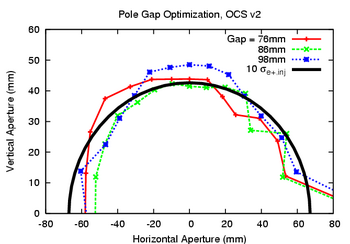 Given the challenge in constructing a 3mm thin
stainless steel support plate, the superferric wiggler pole gap should
be raised by at least 10mm. The observed minimal dynamic aperture
degradation at increased pole gap suggests that the gap could be
raised even more, as long as the current can be increased to achieve
the 25ms ILC damping time target. With a 1.67T peak field, this allows
the wiggler pole gap to be raised to 98mm, leaving a suficient safety
margin below the superconducting quench limit.
Given the challenge in constructing a 3mm thin
stainless steel support plate, the superferric wiggler pole gap should
be raised by at least 10mm. The observed minimal dynamic aperture
degradation at increased pole gap suggests that the gap could be
raised even more, as long as the current can be increased to achieve
the 25ms ILC damping time target. With a 1.67T peak field, this allows
the wiggler pole gap to be raised to 98mm, leaving a suficient safety
margin below the superconducting quench limit.
Optimization: Pole Width
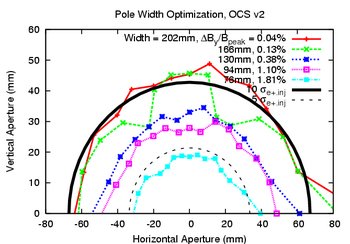 The size of the dynamic aperture depends clearly and
directly on the wiggler pole width. This allows the reduction of the
wiggler width if the benefit of narrower poles outweighs the
minimal-to-significant decrease in dynamic aperture that would happen
at a reduced pole width. Therefore, as long as a smaller dynamic
aperture is acceptable, the wiggler width could be reduced to save
money. However, the increased engineering challenges of a narrower
wiggler support structure and increased photon density on the vacuum
chamber do present a serious barrier to reducing the pole
width. Balancing the cost/benefit ratio of narrower poles against
these challenges leads to a final recommendation to keep the wiggler
pole width at 238mm--the same as the original CESR-c wigglers.
The size of the dynamic aperture depends clearly and
directly on the wiggler pole width. This allows the reduction of the
wiggler width if the benefit of narrower poles outweighs the
minimal-to-significant decrease in dynamic aperture that would happen
at a reduced pole width. Therefore, as long as a smaller dynamic
aperture is acceptable, the wiggler width could be reduced to save
money. However, the increased engineering challenges of a narrower
wiggler support structure and increased photon density on the vacuum
chamber do present a serious barrier to reducing the pole
width. Balancing the cost/benefit ratio of narrower poles against
these challenges leads to a final recommendation to keep the wiggler
pole width at 238mm--the same as the original CESR-c wigglers.
Optimization: Length and Peak Field
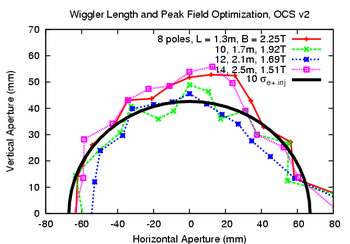
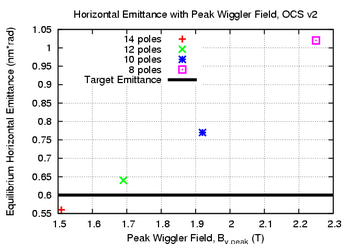
Reducing the number of poles in the ILC damping
wigglers would produce instant cost-savings in the construction of 160
wigglers; however, a shorter wiggler is unlikely given the increase in
horizontal emittance coming from stronger wiggler fields. However,
since the radiation equilibrium horizontal emittance also depends on
the wiggler period, a 12-pole wiggler with a shorter period could
shift the emittance, 0.64nmrad, below the target of
0.60nmrad. Therefore, if the period of a 12-pole wiggler can be
reduced to meet the target emittance, then a 12-pole ILC damping
wiggler could work, otherwise the current 14-pole design should be
used.
Optimization: Period, 12-poles
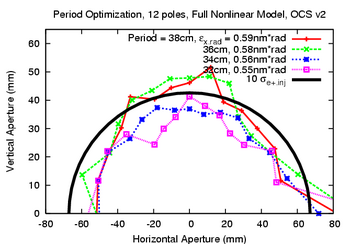 Given these dynamic aperture results, a 32cm wiggler
looks to be above the period where the dynamic aperture starts to
degrade. Reducing the period and pole number from 40cm with 14-poles
to 32cm with 12-poles corresponds to a 31% reduction in total wiggler
length which will greatly reduce the wiggler unit cost.
Given these dynamic aperture results, a 32cm wiggler
looks to be above the period where the dynamic aperture starts to
degrade. Reducing the period and pole number from 40cm with 14-poles
to 32cm with 12-poles corresponds to a 31% reduction in total wiggler
length which will greatly reduce the wiggler unit cost.
The damping time from a 32cm, 12-pole wiggler is 3% higher than the
target; therefore, in a 200ms storage cycle, the beam will be damped
for 7.8 damping times instead of 8 damping times. This will result in
very little decrease in the radiation equilibrium emittance and should
be an acceptable trade-off given the cost savings. A 31% reduction in
total wiggler length corresponds to about a 25% reduction in the cost
of this superferric wiggler. Compared to the modified CESR-c wiggler
which was already twice the length of the CESR-c wiggler (which were
$250,000/wigler), the cost of 160 SIOC wigglers in the ILC will save
$20 million. These cost savings are considerable enough to recommend
that the ILC damping wiggler be designed with 12-poles and a 32cm
period.
Return to top for description of conclusions.
Created November 10, 2006
Modified November 15, 2006

 Given the challenge in constructing a 3mm thin
stainless steel support plate, the superferric wiggler pole gap should
be raised by at least 10mm. The observed minimal dynamic aperture
degradation at increased pole gap suggests that the gap could be
raised even more, as long as the current can be increased to achieve
the 25ms ILC damping time target. With a 1.67T peak field, this allows
the wiggler pole gap to be raised to 98mm, leaving a suficient safety
margin below the superconducting quench limit.
Given the challenge in constructing a 3mm thin
stainless steel support plate, the superferric wiggler pole gap should
be raised by at least 10mm. The observed minimal dynamic aperture
degradation at increased pole gap suggests that the gap could be
raised even more, as long as the current can be increased to achieve
the 25ms ILC damping time target. With a 1.67T peak field, this allows
the wiggler pole gap to be raised to 98mm, leaving a suficient safety
margin below the superconducting quench limit.



